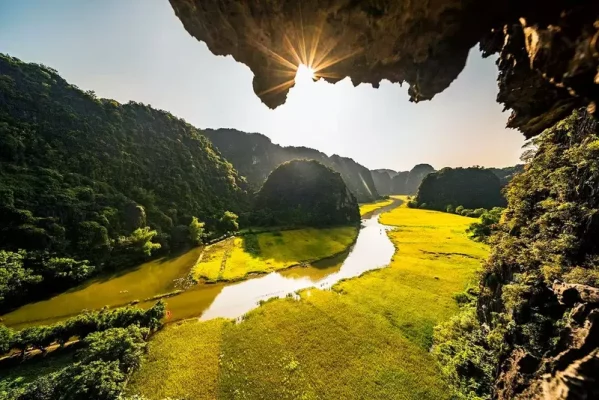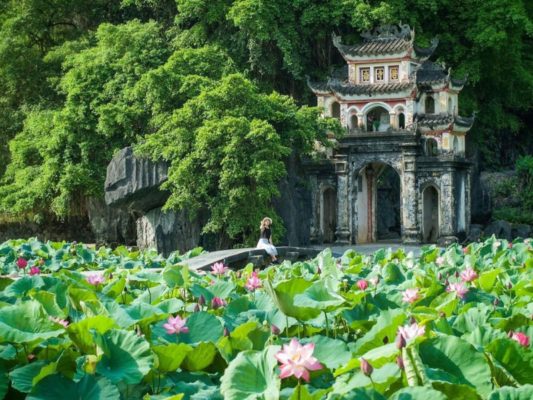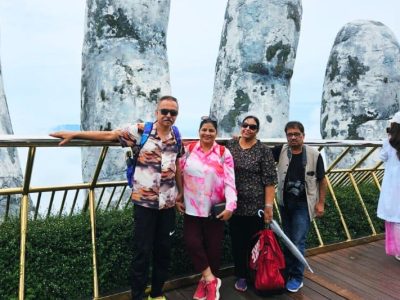Bich Dong Pagoda is an ancient temple within the Trang An Scenic Landscape Complex that has been recognized as a mixed natural and cultural heritage by UNESCO in 2014.
As a part of the Tam Coc – Bich Dong scenic area in the Trang An complex, Bich Dong Pagoda stands as a beautiful wonder, seamlessly blending mountains, caves, and pagodas. In this article, we will delve into the history and architecture of Bich Dong Pagoda, along with providing useful tips for Indian visitors.
Brief History of Bich Dong Pagoda
Established in 1428, Bich Dong Pagoda began as a modest temple atop a mountain. In 1705, two devoted Buddhist monks, Tri Kien and Tri The, met and formed a strong friendship. Then, they embarked on a journey to spread Buddhist teachings and construct temples. Upon encountering the picturesque landscape of Bich Dong, they chose to halt their travels and restore the existing pagoda.

In 1707, the two monks cast a large bell, which still hangs in the Dark Cave of the pagoda. Two years later, they inscribed the pagoda’s history on a stone stele in Chinese. In 1774, Lord Trinh Sam visited the pagoda and was captivated by its breathtaking scenery. He named the pagoda “Bich Dong”, which means “Green Grotto” in Vietnamese.
Between 1740 and 1786, the pagoda underwent restoration and expansion, evolving into three distinct pagodas nestled against the mountainside: the Lower, Middle, and Upper pagodas.
Today, Bich Dong Pagoda remains a magnet for tourists, drawing visitors with its unique architecture, ancient relics, and serene setting amidst scenic mountains and rivers.
Architecture of Bich Dong Pagoda
Bich Dong Pagoda includes three separate pagodas leaning on the mountainside: the Lower Pagoda (Ha Pagoda), the Middle Pagoda (Trung Pagoda), and the Upper Pagoda (Thuong Pagoda). Each has its different features and contributes to the overall beauty of the temple.
Lower Pagoda
The Lower Pagoda is located at the mountain’s base. It has five compartments built on a raised foundation, showing the sophistication and creativity of architects at that time. The horizontal and vertical beams, along with the rafters, are meticulously crafted from ironwood.
The pagoda’s roof boasts two curved tiers and eight eaves, enhancing its aesthetic appeal. The stone columns in the pagoda are solid blocks without joints, standing over 4 meters tall, creating its structural integrity.
Middle Pagoda
From the Lower Pagoda, go up 120 steps along the S-shaped path; the Indian tourists will arrive at the Middle Pagoda. Right in front of the temple are two words, “Bich Dong”, carved into the cliff.
The Middle Pagoda boasts a unique architectural design, with half of it nestled within a mountain cave and the other half exposed to the open air. The pagoda consists of three rooms to worship Buddha.

Upper Pagoda
To reach the Upper Pagoda, Indian visitors must pass through the Dark Cave and ascend nearly 40 stone steps along the mountainside. It is a pagoda located at the highest position, near the top of the mountain.
The Upper Pagoda worships Avalokitesvara Bodhisattva, also known as Guanyin. Flanking the pagoda are two shrines honoring “Tho Dia” (god of the soil) and “Duc Son Than” (god of the mountain). Adjacent to the pagoda, there is a water tank referred to as the “magical water tank” of Avalokitesvara Bodhisattva.

Location
Bich Dong Pagoda is located at the foot of Thai Vien Mountain, Ninh Hai commune, Hoa Lu district, Ninh Binh province, in Northern Vietnam. The pagoda is in Trang An Scenic Landscape Complex.
Opening Hours
Monday to Sunday, 7:30 AM – 5 PM
Entrance Fee
The entrance fee of Bich Dong Pagoda is free. However, if you want to visit Tam Coc along with Bich Dong Pagoda by boat, here are the ticket prices for the Tam Coc – Bich Dong complex for your reference:
- Elderly: 120,000 VND (4.84 USD)
- Adults above 1.3 meters: 250,000 VND (10.3 USD)
- Children from 1 – 1.3 meters: 120,000 VND (4.84 USD)
- Children under 1 meter: Free
The Best Time to Visit
The best times to visit Bich Dong Pagoda are spring (January to March) and summer (May to August). During these periods, Ninh Binh’s weather is pleasant and dry, perfect for outdoor activities.
How to Get Bich Dong Pagoda
Bich Dong Pagoda is in Ninh Binh province of northern Vietnam. Therefore, Indian tourists need to travel to Hanoi and then proceed to Ninh Binh.
The distance between Hanoi and Ninh Binh is around 100km. You can opt to take a bus, book a Limousine, or use a taxi service, with the journey typically lasting over 2 hours.
Upon reaching Ninh Binh, you can take a taxi or motorbike to Van Lam Pier, where you’ll purchase your ticket for the Tam Coc – Bich Dong tour, a popular choice among tourists. During this tour, you’ll embark on a boat trip to explore Tam Coc before reaching Bich Dong Pagoda. In addition, if you don’t want to visit Tam Coc by boat, you can directly access Bich Dong Pagoda by taxi, motorbike, or bicycle.
For a convenient trip to Bich Dong Pagoda, it’s advisable to book a tour package through Vietnamtour.in. We specialize in organizing tours for Indian travelers, ensuring you save time and effort while avoiding any unwanted issues. Our English-speaking tour guide will efficiently arrange your trip to Bich Dong and provide detailed guidance throughout.
Attractions Nearby
Mua Cave
Entrance fee: 100,000 VND/person ( 4.1 USD/person)
Just a short drive from Bich Dong temple, Mua Cave (Hang Mua) beckons Indian tourists with its awe-inspiring views. Climbing 500 stone steps leads you to the summit of Mua Cave, revealing a breathtaking panorama of Ninh Binh’s rivers, rice fields, and majestic mountains.

Hoa Lu
Entrance fee: 20,000 VND/person (0.82 USD/person)
Hoa Lu was the capital of Vietnam from 968 to 1010, spanning three dynasties: Dinh – Early Le – Early Ly. This historic capital is a key component of the Trang An World Heritage Complex, acknowledged by UNESCO.
Trang An Boat Tour
Entrance fee: 250,000 VND/person (10.3 USD/person)
The Trang An boat tour attracts thousands of visitors annually, guiding them through hidden caves, ancient limestone formations, and revered temples.
Bai Dinh Pagoda
Bai Dinh Pagoda, boasting numerous Asian and Vietnamese records, impresses visitors with its grandeur by day and enchants them with its magical beauty by night. Open daily from 6 AM to 9 PM, the temple continues to draw thousands of visitors per day.
Useful Tips
- Dress modestly and respectfully, following pagoda guidelines.
- Remove shoes before entering the main halls.
- Maintain quiet and respectful behavior inside.
- Respect sacred items and make offerings thoughtfully.
- Keep the area clean and hygienic.
- Wear comfortable shoes for climbing stairs and exploring caves.
- Protect yourself from the sunlight with sunscreen, a hat, and sunglasses.
- Bring a water bottle and snacks to sustain your energy.
- Check the weather forecast, especially during the rainy season.
- Enhance your experience with a local guide to learn about the pagoda’s history and culture in depth.
Conclusion
Bich Dong Pagoda in Ninh Binh is a sacred gem of Vietnam, blending stunning landscapes with rich cultural heritage. It’s time for Indian tourists to explore the Bich Dong and many tourist attractions in Ninh Binh. Let’s call us for the best consultant for your trip to Vietnam!
OTHER ATTRACTIONS IN NINH BINH
ITINERARIES WITH BICH DONG PAGODA












